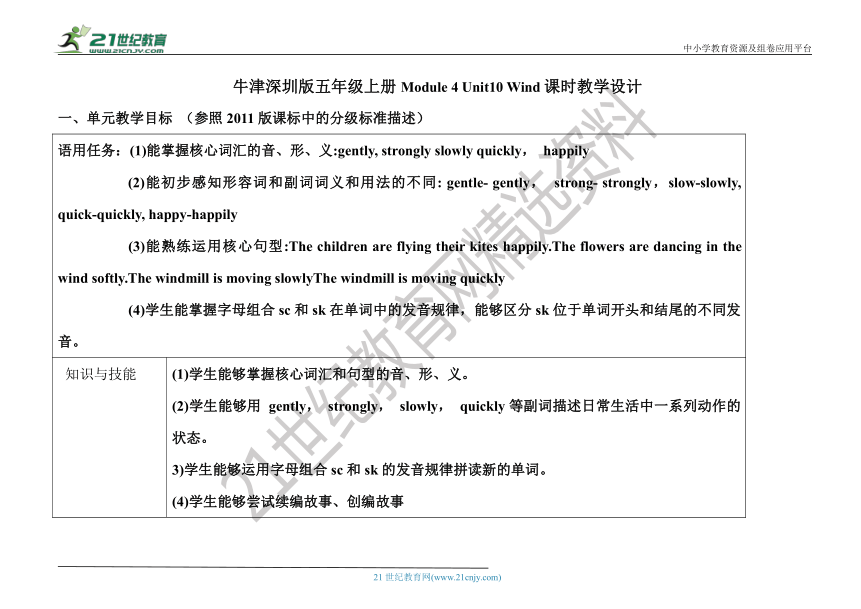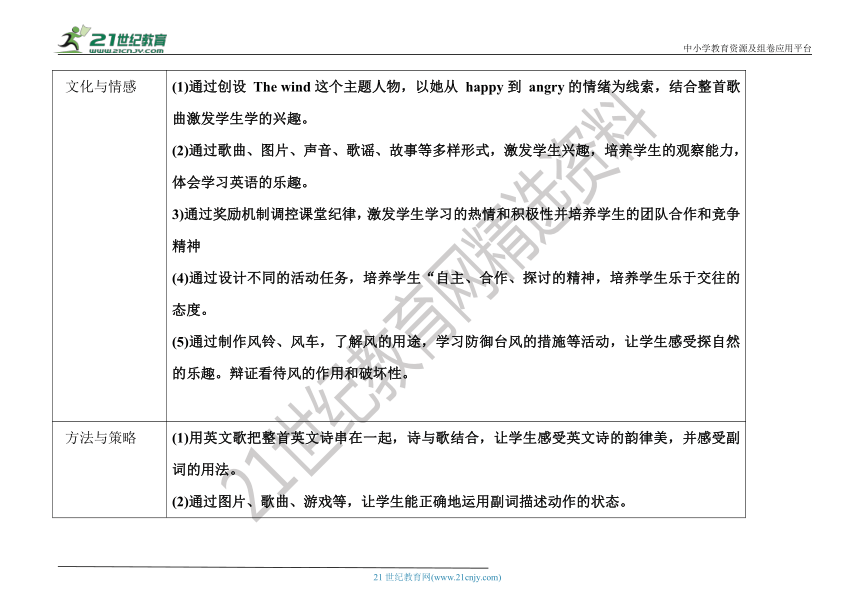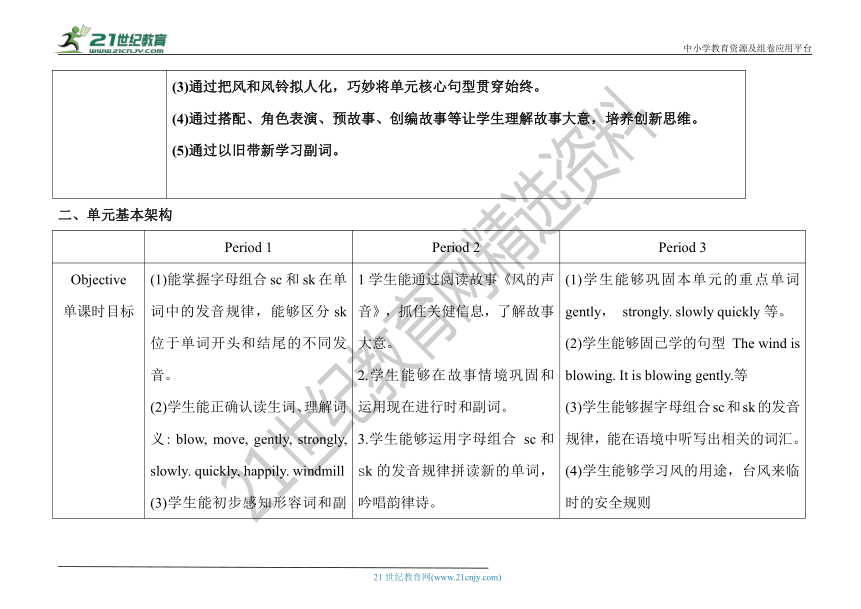Unit10 Wind单元教案
图片预览





文档简介
中小学教育资源及组卷应用平台
牛津深圳版五年级上册Module
4
Unit10
Wind课时教学设计
一、单元教学目标
(参照2011版课标中的分级标准描述)
语用任务:(1)能掌握核心词汇的音、形、义:gently,
strongly
slowly
quickly,
happily(2)能初步感知形容词和副词词义和用法的不同:
gentle-
gently,
strong-
strongly,slow-slowly,
quick-quickly,
happy-happily(3)能熟练运用核心句型:The
children
are
flying
their
kites
happily.The
flowers
are
dancing
in
the
wind
softly.The
windmill
is
moving
slowlyThe
windmill
is
moving
quickly(4)学生能掌握字母组合sc和sk在单词中的发音规律,能够区分sk位于单词开头和结尾的不同发音。
知识与技能
(1)学生能够掌握核心词汇和句型的音、形、义。(2)学生能够用
gently,
strongly,
slowly,
quickly等副词描述日常生活中一系列动作的状态。3)学生能够运用字母组合sc和sk的发音规律拼读新的单词。(4)学生能够尝试续编故事、创编故事
文化与情感
(1)通过创设
The
wind这个主题人物,以她从
happy到
angry的情绪为线索,结合整首歌曲激发学生学的兴趣。(2)通过歌曲、图片、声音、歌谣、故事等多样形式,激发学生兴趣,培养学生的观察能力,体会学习英语的乐趣。3)通过奖励机制调控课堂纪律,激发学生学习的热情和积极性并培养学生的团队合作和竞争精神(4)通过设计不同的活动任务,培养学生“自主、合作、探讨的精神,培养学生乐于交往的态度。(5)通过制作风铃、风车,了解风的用途,学习防御台风的措施等活动,让学生感受探自然的乐趣。辩证看待风的作用和破坏性。
方法与策略
(1)用英文歌把整首英文诗串在一起,诗与歌结合,让学生感受英文诗的韵律美,并感受副词的用法。(2)通过图片、歌曲、游戏等,让学生能正确地运用副词描述动作的状态。(3)通过把风和风铃拟人化,巧妙将单元核心句型贯穿始终。(4)通过搭配、角色表演、预故事、创编故事等让学生理解故事大意,培养创新思维。(5)通过以旧带新学习副词。
二、单元基本架构
Period
1
Period
2
Period
3
Objective单课时目标
(1)能掌握字母组合sc和sk在单词中的发音规律,能够区分sk位于单词开头和结尾的不同发音。(2)学生能正确认读生词、理解词义:
blow,
move,
gently,
strongly,
slowly.
quickly,
happily.
windmill(3)学生能初步感知形容词和副词词义和用法的不同:
gentle-
gently,
strong
-
strongly(4)学生能初步感知副词在句子中的用法,并能试着用其来描述日常生活中一系列动作的状态。The
children
are
flying
their
kites
happily.The
flowers
are
dancing
in
the
wind
softly.The
windmill
is
moving
slowly.The
windmill
is
moving
quickly.(5)多种形式激发学生学习的兴趣及培养他们热爱自然的情感。
1学生能通过阅读故事《风的声音》,抓住关健信息,了解故事大意。2.学生能够在故事情境巩固和运用现在进行时和副词。3.学生能够运用字母组合
sc和sk的发音规律拼读新的单词,吟唱韵律诗。4.学生能够提高预测故事、合作学习的能力
(1)学生能够巩固本单元的重点单词
gently,
strongly.
slowly
quickly等。(2)学生能够固已学的句型
The
wind
is
blowing.
It
is
blowing
gently.等(3)学生能够握字母组合sc和sk的发音规律,能在语境中听写出相关的词汇。(4)学生能够学习风的用途,台风来临时的安全规则
Topic单课时话题
The
song
of
the
wind
The
sound
of
the
wind
The
wind
workshop
Content单课时教学文本
The
wind
is
happy,
so
happy.It
is
blowing
gently.The
flowers
are
dancing
in
the
wind
softly.The
wind
is
happy,
so
happy.It
is
blowing
gently.The
windmill
is
moving,moving
slowly.The
wind
is
angry,
so
angry.It
is
blowing
strongly.The
children
are
flying
their
kites
happily.The
wind
is
angry,
so
angry.It
is
blowing
strongly.The
windmill
is
moving,moving
quickly.
Tink-tinkWow!That’s
the
sound
of
the
wind.Little
Duck
has
a
wind-bell
on
her
window.Clink-clink!It’s
like
music.
I
love
it.Little
Rabbit
has
a
wind-bell
in
her
room.I
like
the
sound
of
the
wind.
Me
too.Little
Pig
wants
to
hear
the
sound
of
the
wind
too.
Little
pig
is
cutting
some
paper.
He
wants
to
make
a
paper
wind-bell.It’s
too
quiet.
Why The
wind
is
blowing
gently.
Little
Pig
hears
the
sound
of
the
wind
.
He
doesn’t
like
it.
1.
Learn
the
sounds
2.
Wind
is
useful
3.
Typhoon
rules
4.
How
to
make
a
windmil
5.
Write
a
diary
Blackboard
design板书设计
Unit
10
WindThe
wind
is
happy,
so
happy.It
is
blowing
gently.The
flowers
are
dancing
in
the
wind
softly.The
windmill
is
moving
slowly.The
wind
is
angry,
so
angry.It
is
blowing
strongly.The
children
are
flying
their
kites
happily.The
windmill
is
moving
quickly
.
三、单课教学设计
Period
1
Procedures
Contents
Methods
Purpose
Pre-lesson
Greeting.
1.How
are
you
today
How
is
the
weather
today
1.拉近师生距离,做好上课准备。
Pre-task
preparation
1.语音导入:a.出示一幅图片,引导学生回答:“what
can
you
see
in
the
picture
”b.呈现含有/sk/的新单词c.辨别/sk/在不同位置时的发音d.
Say
a
chant2.A
guessing
game3.
主题人物The
wind出现。4.用语音教授blow。
a.
引导学生回答“what
can
you
see
in
the
picture
”,进而引出scarf,
skip等单词。
b.展示单词scary,
skip,
skateboard,
scarf,
并带读。c.
呈现两组词,分别是:scarf,
skip,
scary,
skate跟desk,
mask,
ask,
task让学生读并感受和发现不同,最后揭示规律。d.
带读2.播放音频:I
can
make
flowers
dance.
I
can
make
kites
fly.I
can
make
windmills
move.I
can
make
peopleFeel
cool.
Who
am
I
3.
呈现图片并介绍:
Haha...
Yes,
I'm
the
wind.
I
can
blow.
I'm
so
happy.
4.
呈现图片,引出black
window,用一首chant让孩子们把bl跟ow结合起来拼成blow。
Black,
black,
bl,
bl,
bl
Window,
window,
ow,
ow,
ow.
I
can
blow
the
candles.
Blow,
blow,
blow!
a.
为了引出含有/sk/的几个单词:
scarf,
skip等b.练习/sk/的发音。c.
让学生意识到字母组合sk在单词前面是变音为/sg/。d.
通过chant的形式训练发音,并引出the
wind
话题。2.
通过谜语激发学生的学习兴趣并为引出本节课话题做准。3.
把the
wind拟人化,引发学生的好奇心。4.
让孩子们学习blow的音形义。
While-task
procedure
1.播放歌曲前两句:The
wind
is
happy,
so
happy.It
is
blowing
gently.2.呈现图片教授单词gently。3.重新播放歌曲,并呈现图片,让学生想象What
will
happen
when
the
wind
is
blowing
genlly.4.通过图片,用phonics教授windmill.教授单词move。5.播放歌曲前6句:The
wind
is
happy,
so
happy.It
is
blowing
gently.The
flowers
are
dancing
in
the
wind
softly….6.The
wind
出现:
You're
not
good
singers.I
am
angry
now.播放下一段歌曲:
The
wind
is
angry
so
angry.It
is
blowing
strongly.7.
呈现两副图,让学生感受strong
wind带来的效果。8.
Say
a
chant
and
fill
in
the
blanks.9.播放后半部分歌曲。10.播放整首歌。
1.老师跟唱并用动作展示gently2.
带读,并让学生体会gentle与gently的区别跟转换。3.
带唱歌曲前两句,加上动作,呈现图片,让学生fill
in
the
blanks.The
flowers
are
___
in
the
wind____.让学生通过图片完成softly的句子。4.
先呈现图片,让学生填充The
windmill
is__
__
__.同时利用hill跟mill让学生自己拼读windmill.同时用一首chant让学生理解move跟moving.5.带唱,请小组唱,个人唱,并加上动作。6.
带唱歌曲,并加动作。让学生感受strong跟strongly的不同。带读各个单词,从形容词变概成副词的例子。7.教授happily跟quickly8.带读chant.9.带唱。10.带唱。
1.用歌曲的方式带出gently。2.
通过图片跟句型:I
am
a
gentle
man.
I
talk
to
people
gently.
带出单词:
gently3.让学生感受风轻轻吹的场景,并想象风轻轻吹带来的景象,同时教授softly,通过图片让学生用softly造句。4.让学生通过phonics熟态windmill的音形义,并让学生感受move的意思。5.
通过歌曲的串编,让学生朗朗上口,并很快熟悉课文内容。6.引出strongly,并把strong跟strongly做一个对比。这里对形容词变成副词进行一点拓展,让学生有一种概念,分成三种变法。7.
引导学生fill
in
the
blanks.The
children
are
___their
kites___The
windmill
is
moving
___.8.
让学生体会quickly与slowly的区别。9.熟悉后半部分内容。10.熟悉整个歌曲内容。
Post-task
activity
1.操练与巩固:The
wind:“You
sing
so
well
now.
Doyou
want
to
be
my
friends.”完成任务一。2.完成任务二:look
and
say3.完成任务三:风车任意转4.
Lite
Duck,Litle
Pig
and
Litle
rabbit完成任务变成了Wind的好朋友,读对话并表演,编新对话。5.Summarise
1.播放视频,让学生跟着有感情的阅读诗歌。2.呈现图片,让学生根据图片完成句子。3.引导学生组成通顺的句子。4.分角色朗读对话并表演,从而编新的对话。5.老师通过图片引导学生体会:“the
wind
makes
our
life
colourful
!”
1.
look
and
read
2.look
and
say
and
fill
in
the
blanks.3.让学生学会用副词造句子。4.鼓励学生大胆表演。5.播放图片,感受风带来的场景。
Assignment
1.
Listen
to
and
read
the
passage
on
pages
68.2.
Sing
the
song.3.
Use
pictures
and
words
to
describe
the
gentle
wind
and
the
strong
wind.
Period
2
Procedures
Contents
Methods
Purpose
Pre-lesson
1.Greeting.Sing
the
chant.3.Quick
response:What
can
you
hear
1.How
are
you
today How’s
the
weather What’s
the
date
today 领读chant引导学生用功能句:That’s
the
sound
of____.
来回答:What
can
you
hear
1.用学生熟悉的话题进入课堂,引导学生做好上课的准备。巩固学习sc/sk的发音,及活跃课堂气氛。为了引出主题:The
sound
of
the
wind.
Pre-task
preparation
1.Watch
the
story.(The
sound
of
wind)
1.Ask:(1)What
can
you
see (2)What
do
they
have (3)Can
you
macth
整体感知故事
While-task
procedure
1..Play
a
part
of
the
story.(Little
Duck
talk
to
the
wind-bell,Little
Rabbit
talk
to
the
wind-bell
,Little
Rabbit
talk
to
Little
Duck)
and
fill
in
blank.2.Predict
the
story:
guess
Little
pig’s
good
idea.3.Look
and
learn.(cut)4.Play
a
part
of
the
story.(Little
pig
talk
to
wind-bell
Papa)5.Predict
the
story(Talk
about
the
reason
for
Little
pig
don’t
like
his
wind-bell)It’s
too
quiet.
Why
1.(1)播放音频,提出问题,请学生Fill
in
the
blanks.(2)小组合作,分配角色扮演任务2.播放音频,提出问题:
Can
you
guess,
what
does
Little
pig
want
to
do 3.播放视频,提出问题请学生Fill
in
the
blanks.4.
(1)播放音频,提出问题,请学生Fill
in
the
blanks.(2)小组合作,分配角色扮演任务5.播放音频,提出问题,请学生Fill
in
the
blanks.
并提出问题。It’s
too
quiet.
Why
1.1)通过风铃拟人的对白,巩固I
am
dacing
happily.I
am
singing
loudly.The
sound
of
the
wind
及日常用语“Me
too.”此类句型。2)通过角色扮演加深对故事的理解。3)拓展风铃的材质。2.通过预测故事来训练发散思维,培养创新能力及语言使用能力。3.通过fill
in
the
blank,抓取核心信息,并利用金字塔形的chant巩固核心词汇。4.
1)通过风铃拟人化的对白,巩固:I
am
sleeping
quietly.此类句型2)通过角色扮演加深对故事的理解。3)拓展风铃的材质。5.
通过预测故事来训练发散思维,培养创新能力及语言使用能力
Post-task
activity
1.Try
to
help
Little
pig.2.Know
the
materials
of
the
bells3.Retell
the
story.4.Role
play.
1.给出思维导图,并提出问题:Little
pig
doesn’t
like
his
wind-bell.
Can
you
help
him
,
最终引导学生回答Maybe
we
can
make
a
new
wind-bell
for
him.2.播放音频、图片及风铃材质对应的英文表述,并给出功能句:Let’s
make
a
new
wind-bell
for
him.
We
can
use
____.3.给出功能图,学生看图复述故事。4.提供故事图片,给与学生充足的时间进行小组演练。
1.
通过预测故事来训练发散思维,培养创新能力及语言使用能力2.通过了解风铃材质及各种创意风铃,激发学生探索新事物的兴趣,培养学生的求异思维和动手能力。3.通过复述故事,更能层次理解故事,并掌握核心句型的掌握。4.
通过角色扮演加深对故事的理解;通过续编、改编故事训练发散思维,培养创新能力和对语言的综合实践能力。
Assignment
1.Retell
the
story
on
P70
to
your
parents.
2.
Make
a
new
wind-bell
and
do
role
play
with
your
friends.
21世纪教育网
www.21cnjy.com
精品试卷·第
2
页
(共
2
页)
HYPERLINK
"http://www.21cnjy.com/"
21世纪教育网(www.21cnjy.com)
牛津深圳版五年级上册Module
4
Unit10
Wind课时教学设计
一、单元教学目标
(参照2011版课标中的分级标准描述)
语用任务:(1)能掌握核心词汇的音、形、义:gently,
strongly
slowly
quickly,
happily(2)能初步感知形容词和副词词义和用法的不同:
gentle-
gently,
strong-
strongly,slow-slowly,
quick-quickly,
happy-happily(3)能熟练运用核心句型:The
children
are
flying
their
kites
happily.The
flowers
are
dancing
in
the
wind
softly.The
windmill
is
moving
slowlyThe
windmill
is
moving
quickly(4)学生能掌握字母组合sc和sk在单词中的发音规律,能够区分sk位于单词开头和结尾的不同发音。
知识与技能
(1)学生能够掌握核心词汇和句型的音、形、义。(2)学生能够用
gently,
strongly,
slowly,
quickly等副词描述日常生活中一系列动作的状态。3)学生能够运用字母组合sc和sk的发音规律拼读新的单词。(4)学生能够尝试续编故事、创编故事
文化与情感
(1)通过创设
The
wind这个主题人物,以她从
happy到
angry的情绪为线索,结合整首歌曲激发学生学的兴趣。(2)通过歌曲、图片、声音、歌谣、故事等多样形式,激发学生兴趣,培养学生的观察能力,体会学习英语的乐趣。3)通过奖励机制调控课堂纪律,激发学生学习的热情和积极性并培养学生的团队合作和竞争精神(4)通过设计不同的活动任务,培养学生“自主、合作、探讨的精神,培养学生乐于交往的态度。(5)通过制作风铃、风车,了解风的用途,学习防御台风的措施等活动,让学生感受探自然的乐趣。辩证看待风的作用和破坏性。
方法与策略
(1)用英文歌把整首英文诗串在一起,诗与歌结合,让学生感受英文诗的韵律美,并感受副词的用法。(2)通过图片、歌曲、游戏等,让学生能正确地运用副词描述动作的状态。(3)通过把风和风铃拟人化,巧妙将单元核心句型贯穿始终。(4)通过搭配、角色表演、预故事、创编故事等让学生理解故事大意,培养创新思维。(5)通过以旧带新学习副词。
二、单元基本架构
Period
1
Period
2
Period
3
Objective单课时目标
(1)能掌握字母组合sc和sk在单词中的发音规律,能够区分sk位于单词开头和结尾的不同发音。(2)学生能正确认读生词、理解词义:
blow,
move,
gently,
strongly,
slowly.
quickly,
happily.
windmill(3)学生能初步感知形容词和副词词义和用法的不同:
gentle-
gently,
strong
-
strongly(4)学生能初步感知副词在句子中的用法,并能试着用其来描述日常生活中一系列动作的状态。The
children
are
flying
their
kites
happily.The
flowers
are
dancing
in
the
wind
softly.The
windmill
is
moving
slowly.The
windmill
is
moving
quickly.(5)多种形式激发学生学习的兴趣及培养他们热爱自然的情感。
1学生能通过阅读故事《风的声音》,抓住关健信息,了解故事大意。2.学生能够在故事情境巩固和运用现在进行时和副词。3.学生能够运用字母组合
sc和sk的发音规律拼读新的单词,吟唱韵律诗。4.学生能够提高预测故事、合作学习的能力
(1)学生能够巩固本单元的重点单词
gently,
strongly.
slowly
quickly等。(2)学生能够固已学的句型
The
wind
is
blowing.
It
is
blowing
gently.等(3)学生能够握字母组合sc和sk的发音规律,能在语境中听写出相关的词汇。(4)学生能够学习风的用途,台风来临时的安全规则
Topic单课时话题
The
song
of
the
wind
The
sound
of
the
wind
The
wind
workshop
Content单课时教学文本
The
wind
is
happy,
so
happy.It
is
blowing
gently.The
flowers
are
dancing
in
the
wind
softly.The
wind
is
happy,
so
happy.It
is
blowing
gently.The
windmill
is
moving,moving
slowly.The
wind
is
angry,
so
angry.It
is
blowing
strongly.The
children
are
flying
their
kites
happily.The
wind
is
angry,
so
angry.It
is
blowing
strongly.The
windmill
is
moving,moving
quickly.
Tink-tinkWow!That’s
the
sound
of
the
wind.Little
Duck
has
a
wind-bell
on
her
window.Clink-clink!It’s
like
music.
I
love
it.Little
Rabbit
has
a
wind-bell
in
her
room.I
like
the
sound
of
the
wind.
Me
too.Little
Pig
wants
to
hear
the
sound
of
the
wind
too.
Little
pig
is
cutting
some
paper.
He
wants
to
make
a
paper
wind-bell.It’s
too
quiet.
Why The
wind
is
blowing
gently.
Little
Pig
hears
the
sound
of
the
wind
.
He
doesn’t
like
it.
1.
Learn
the
sounds
2.
Wind
is
useful
3.
Typhoon
rules
4.
How
to
make
a
windmil
5.
Write
a
diary
Blackboard
design板书设计
Unit
10
WindThe
wind
is
happy,
so
happy.It
is
blowing
gently.The
flowers
are
dancing
in
the
wind
softly.The
windmill
is
moving
slowly.The
wind
is
angry,
so
angry.It
is
blowing
strongly.The
children
are
flying
their
kites
happily.The
windmill
is
moving
quickly
.
三、单课教学设计
Period
1
Procedures
Contents
Methods
Purpose
Pre-lesson
Greeting.
1.How
are
you
today
How
is
the
weather
today
1.拉近师生距离,做好上课准备。
Pre-task
preparation
1.语音导入:a.出示一幅图片,引导学生回答:“what
can
you
see
in
the
picture
”b.呈现含有/sk/的新单词c.辨别/sk/在不同位置时的发音d.
Say
a
chant2.A
guessing
game3.
主题人物The
wind出现。4.用语音教授blow。
a.
引导学生回答“what
can
you
see
in
the
picture
”,进而引出scarf,
skip等单词。
b.展示单词scary,
skip,
skateboard,
scarf,
并带读。c.
呈现两组词,分别是:scarf,
skip,
scary,
skate跟desk,
mask,
ask,
task让学生读并感受和发现不同,最后揭示规律。d.
带读2.播放音频:I
can
make
flowers
dance.
I
can
make
kites
fly.I
can
make
windmills
move.I
can
make
peopleFeel
cool.
Who
am
I
3.
呈现图片并介绍:
Haha...
Yes,
I'm
the
wind.
I
can
blow.
I'm
so
happy.
4.
呈现图片,引出black
window,用一首chant让孩子们把bl跟ow结合起来拼成blow。
Black,
black,
bl,
bl,
bl
Window,
window,
ow,
ow,
ow.
I
can
blow
the
candles.
Blow,
blow,
blow!
a.
为了引出含有/sk/的几个单词:
scarf,
skip等b.练习/sk/的发音。c.
让学生意识到字母组合sk在单词前面是变音为/sg/。d.
通过chant的形式训练发音,并引出the
wind
话题。2.
通过谜语激发学生的学习兴趣并为引出本节课话题做准。3.
把the
wind拟人化,引发学生的好奇心。4.
让孩子们学习blow的音形义。
While-task
procedure
1.播放歌曲前两句:The
wind
is
happy,
so
happy.It
is
blowing
gently.2.呈现图片教授单词gently。3.重新播放歌曲,并呈现图片,让学生想象What
will
happen
when
the
wind
is
blowing
genlly.4.通过图片,用phonics教授windmill.教授单词move。5.播放歌曲前6句:The
wind
is
happy,
so
happy.It
is
blowing
gently.The
flowers
are
dancing
in
the
wind
softly….6.The
wind
出现:
You're
not
good
singers.I
am
angry
now.播放下一段歌曲:
The
wind
is
angry
so
angry.It
is
blowing
strongly.7.
呈现两副图,让学生感受strong
wind带来的效果。8.
Say
a
chant
and
fill
in
the
blanks.9.播放后半部分歌曲。10.播放整首歌。
1.老师跟唱并用动作展示gently2.
带读,并让学生体会gentle与gently的区别跟转换。3.
带唱歌曲前两句,加上动作,呈现图片,让学生fill
in
the
blanks.The
flowers
are
___
in
the
wind____.让学生通过图片完成softly的句子。4.
先呈现图片,让学生填充The
windmill
is__
__
__.同时利用hill跟mill让学生自己拼读windmill.同时用一首chant让学生理解move跟moving.5.带唱,请小组唱,个人唱,并加上动作。6.
带唱歌曲,并加动作。让学生感受strong跟strongly的不同。带读各个单词,从形容词变概成副词的例子。7.教授happily跟quickly8.带读chant.9.带唱。10.带唱。
1.用歌曲的方式带出gently。2.
通过图片跟句型:I
am
a
gentle
man.
I
talk
to
people
gently.
带出单词:
gently3.让学生感受风轻轻吹的场景,并想象风轻轻吹带来的景象,同时教授softly,通过图片让学生用softly造句。4.让学生通过phonics熟态windmill的音形义,并让学生感受move的意思。5.
通过歌曲的串编,让学生朗朗上口,并很快熟悉课文内容。6.引出strongly,并把strong跟strongly做一个对比。这里对形容词变成副词进行一点拓展,让学生有一种概念,分成三种变法。7.
引导学生fill
in
the
blanks.The
children
are
___their
kites___The
windmill
is
moving
___.8.
让学生体会quickly与slowly的区别。9.熟悉后半部分内容。10.熟悉整个歌曲内容。
Post-task
activity
1.操练与巩固:The
wind:“You
sing
so
well
now.
Doyou
want
to
be
my
friends.”完成任务一。2.完成任务二:look
and
say3.完成任务三:风车任意转4.
Lite
Duck,Litle
Pig
and
Litle
rabbit完成任务变成了Wind的好朋友,读对话并表演,编新对话。5.Summarise
1.播放视频,让学生跟着有感情的阅读诗歌。2.呈现图片,让学生根据图片完成句子。3.引导学生组成通顺的句子。4.分角色朗读对话并表演,从而编新的对话。5.老师通过图片引导学生体会:“the
wind
makes
our
life
colourful
!”
1.
look
and
read
2.look
and
say
and
fill
in
the
blanks.3.让学生学会用副词造句子。4.鼓励学生大胆表演。5.播放图片,感受风带来的场景。
Assignment
1.
Listen
to
and
read
the
passage
on
pages
68.2.
Sing
the
song.3.
Use
pictures
and
words
to
describe
the
gentle
wind
and
the
strong
wind.
Period
2
Procedures
Contents
Methods
Purpose
Pre-lesson
1.Greeting.Sing
the
chant.3.Quick
response:What
can
you
hear
1.How
are
you
today How’s
the
weather What’s
the
date
today 领读chant引导学生用功能句:That’s
the
sound
of____.
来回答:What
can
you
hear
1.用学生熟悉的话题进入课堂,引导学生做好上课的准备。巩固学习sc/sk的发音,及活跃课堂气氛。为了引出主题:The
sound
of
the
wind.
Pre-task
preparation
1.Watch
the
story.(The
sound
of
wind)
1.Ask:(1)What
can
you
see (2)What
do
they
have (3)Can
you
macth
整体感知故事
While-task
procedure
1..Play
a
part
of
the
story.(Little
Duck
talk
to
the
wind-bell,Little
Rabbit
talk
to
the
wind-bell
,Little
Rabbit
talk
to
Little
Duck)
and
fill
in
blank.2.Predict
the
story:
guess
Little
pig’s
good
idea.3.Look
and
learn.(cut)4.Play
a
part
of
the
story.(Little
pig
talk
to
wind-bell
Papa)5.Predict
the
story(Talk
about
the
reason
for
Little
pig
don’t
like
his
wind-bell)It’s
too
quiet.
Why
1.(1)播放音频,提出问题,请学生Fill
in
the
blanks.(2)小组合作,分配角色扮演任务2.播放音频,提出问题:
Can
you
guess,
what
does
Little
pig
want
to
do 3.播放视频,提出问题请学生Fill
in
the
blanks.4.
(1)播放音频,提出问题,请学生Fill
in
the
blanks.(2)小组合作,分配角色扮演任务5.播放音频,提出问题,请学生Fill
in
the
blanks.
并提出问题。It’s
too
quiet.
Why
1.1)通过风铃拟人的对白,巩固I
am
dacing
happily.I
am
singing
loudly.The
sound
of
the
wind
及日常用语“Me
too.”此类句型。2)通过角色扮演加深对故事的理解。3)拓展风铃的材质。2.通过预测故事来训练发散思维,培养创新能力及语言使用能力。3.通过fill
in
the
blank,抓取核心信息,并利用金字塔形的chant巩固核心词汇。4.
1)通过风铃拟人化的对白,巩固:I
am
sleeping
quietly.此类句型2)通过角色扮演加深对故事的理解。3)拓展风铃的材质。5.
通过预测故事来训练发散思维,培养创新能力及语言使用能力
Post-task
activity
1.Try
to
help
Little
pig.2.Know
the
materials
of
the
bells3.Retell
the
story.4.Role
play.
1.给出思维导图,并提出问题:Little
pig
doesn’t
like
his
wind-bell.
Can
you
help
him
,
最终引导学生回答Maybe
we
can
make
a
new
wind-bell
for
him.2.播放音频、图片及风铃材质对应的英文表述,并给出功能句:Let’s
make
a
new
wind-bell
for
him.
We
can
use
____.3.给出功能图,学生看图复述故事。4.提供故事图片,给与学生充足的时间进行小组演练。
1.
通过预测故事来训练发散思维,培养创新能力及语言使用能力2.通过了解风铃材质及各种创意风铃,激发学生探索新事物的兴趣,培养学生的求异思维和动手能力。3.通过复述故事,更能层次理解故事,并掌握核心句型的掌握。4.
通过角色扮演加深对故事的理解;通过续编、改编故事训练发散思维,培养创新能力和对语言的综合实践能力。
Assignment
1.Retell
the
story
on
P70
to
your
parents.
2.
Make
a
new
wind-bell
and
do
role
play
with
your
friends.
21世纪教育网
www.21cnjy.com
精品试卷·第
2
页
(共
2
页)
HYPERLINK
"http://www.21cnjy.com/"
21世纪教育网(www.21cnjy.com)
同课章节目录
- Module 1 Getting to know each othe
- Unit 1 My future
- Unit 2 Going to school
- Unit 3 My birthday
- Revision 1
- Project 1
- Module 2 Relationships
- Unit 4 Grandparents
- Unit 5 Friends
- Unit 6 Family life
- Revision 2
- Project 2
- Module 3 Out and about
- Unit 7 At the beach
- Unit 8 An outing
- Unit 9 Around the city
- Revision 3
- Project 3
- Module 4 The natural world
- Unit 10 Wind
- Unit 11 Wate
- Unit 12 Fire
- Revision 4
- Project 4
